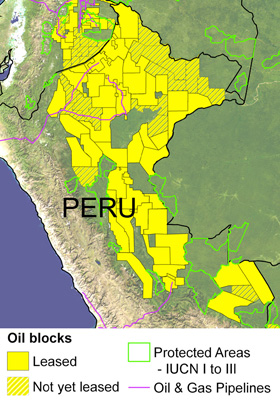 At least 30 are dead following a clash between police and Indians protesting oil development in Peru’s Amazon region. The Associated Press (AP) and other sources are reporting the violence broke out when authorities attempted to penetrate a road blockade by some 5,000 Indians in the northern province of Utcubamba. “Protest leaders said police opened fire from helicopters with bullets and tear gas, while national police director Jose Sanchez Farfan said Indians attacked officers with firearms,” the AP reported. “He said they also set fire to government buildings.” At least 22 indians and eight police officers were killed. Another 50 protesters were injured according to Indian leader Alberto Pizango. Indigenous groups have been blocking roads, waterways and a state oil pipeline in protest of the President Alan Garcia’s attempt to open vast tracts of the Amazon to oil and gas developers as part of a free trade agreement with the United States. More than 70 percent of the Peruvian Amazon is now under foreign concession. Garcia last month declared a state of emergency in four Amazon provinces affected by protests, suspending some constitutional rights and calling upon the army to help restore order so oil and gas operations could resume. … Peruvian police kill 22 Indians in battle over Amazon oil drilling
At least 30 are dead following a clash between police and Indians protesting oil development in Peru’s Amazon region. The Associated Press (AP) and other sources are reporting the violence broke out when authorities attempted to penetrate a road blockade by some 5,000 Indians in the northern province of Utcubamba. “Protest leaders said police opened fire from helicopters with bullets and tear gas, while national police director Jose Sanchez Farfan said Indians attacked officers with firearms,” the AP reported. “He said they also set fire to government buildings.” At least 22 indians and eight police officers were killed. Another 50 protesters were injured according to Indian leader Alberto Pizango. Indigenous groups have been blocking roads, waterways and a state oil pipeline in protest of the President Alan Garcia’s attempt to open vast tracts of the Amazon to oil and gas developers as part of a free trade agreement with the United States. More than 70 percent of the Peruvian Amazon is now under foreign concession. Garcia last month declared a state of emergency in four Amazon provinces affected by protests, suspending some constitutional rights and calling upon the army to help restore order so oil and gas operations could resume. … Peruvian police kill 22 Indians in battle over Amazon oil drilling
Oil or Death in the Amazon
Commentary by Jennifer Jacobs, Rudolf von May, and Alessandro Catenazzi
More than 70% of the Peruvian Amazon has been allocated for oil and gas extraction, and the current government of Alan Garcia has been pushing for more. Unfortunately, as usual, these policies are promoted by and only benefit a handful of people, but negatively impact the lives of many. However, Garcia’s government did not foresee the potential consequences of their actions. An excellent paper published in August 2008 by Dr. Matt Finer and collaborators, Oil and gas Projects in the Western Amazon: Threats to Wilderness, biodiversity and Indigenous Peoples, predicted that “environmental and social impacts are likely to intensify without improved policies” regarding the way that Amazonian governments conduct resource extraction. Yesterday, we witnessed the authors’ predictions come true when a number of indigenous civilians and police died as a result of violent clashes over oil and human rights in northern Peru. Indigenous people in Peru have been protesting the Garcia government’s newly created laws that favor and facilitate rapid oil and natural gas extraction in Amazonian Peru. Many of the oil and gas concessions that the government has granted overlap with areas already protected for wildlife and indigenous groups (see Finer et al. 2008 for a detailed account). A number of international news agencies are reporting on this violent conflict, though the victims and perpetrators of the clash change depending on the source. …
Oil or Death in the Amazon
At least 30 are dead following a clash between police and Indians protesting oil development in Peru’s Amazon region. The Associated Press (AP) and other sources are reporting the violence broke out when authorities attempted to penetrate a road blockade by some 5,000 Indians in the northern province of Utcubamba. “Protest leaders said police opened fire from helicopters with bullets and tear gas, while national police director Jose Sanchez Farfan said Indians attacked officers with firearms,” the AP reported. “He said they also set fire to government buildings.” At least 22 indians and eight police officers were killed. Another 50 protesters were injured according to Indian leader Alberto Pizango. Indigenous groups have been blocking roads, waterways and a state oil pipeline in protest of the President Alan Garcia’s attempt to open vast tracts of the Amazon to oil and gas developers as part of a free trade agreement with the United States. More than 70 percent of the Peruvian Amazon is now under foreign concession. Garcia last month declared a state of emergency in four Amazon provinces affected by protests, suspending some constitutional rights and calling upon the army to help restore order so oil and gas operations could resume. … Peruvian police kill 22 Indians in battle over Amazon oil drilling